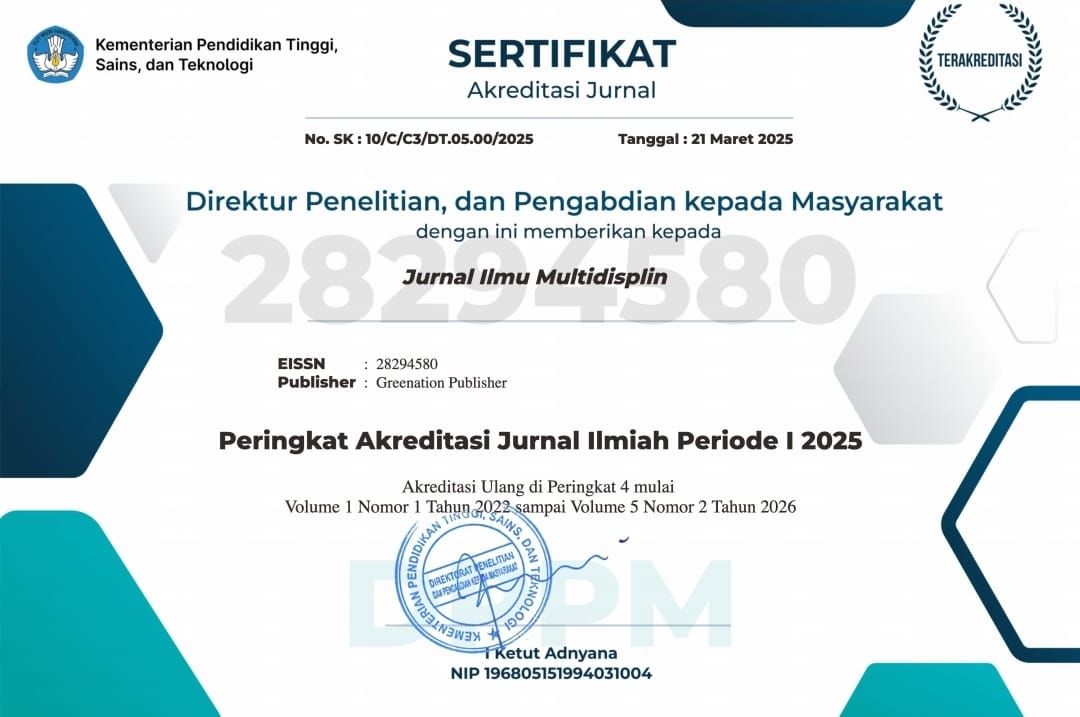Literature Review Faktor-Faktor yang Mempengaruhi Infrastruktur TI: Software, fleksibilitas TI DAN Kinerja Organisasi
DOI:
https://doi.org/10.38035/jim.v1i1.2Keywords:
Infrastruktur TI, Software, Fleksibilitas TI, Kinerja OrganisasiAbstract
Artikel ini membahas tentang studi literature review Sistem Informasi Bisnis, menganalisis Faktor-faktor yang mempengaruhi Infrastruktur TI: Software, Fleksibilitas TI dan Kinerja Organisasi. Metode penulisan artikel ini dengan studi literature atau library reseseach. Hasilnya adalah bahwa: 1) Software memiliki hubungan dan berpengaruh terhadap Infrastruktur TI; 2) Fleksibilitas TI memiliki hubungan dan berpengaruh terhadap Infrastruktur TI; dan 3) Kinerja Organisasi memiliki hubungan dan berpengaruh terhadap Infrastruktur TI.
References
Aima, H. R. (2017). Model of Employee Performance: Competence Analysis and Motivation *Case Study at PT. Bank Bukopin, Tbk Center). Journal of Research in Business and Management, 49-59.
Akintoye, A. ,. (2012). Construction Innovation and Process Improvement. West Sussex: Wiley-Blackwell.
Ali, H. (2009). Sistem Informasi Manajemen, Berbasis Teknologi Informasi. Jogyakarta: Hasta Cipta Mandiri.
Ali, H. d. (2010). Technopreneurship Dalam Perspektif Bisnis Online. Baduose Media.
Ali, H. d. (2013). Metode Penelitian (Petunjuk Praktis untuk Pemecahan Masalah Bisnis, Penyusunan Skripsi, Tesis, dan Disertasi).
Anggraini, N. D. (2013). Pengaruh Praktek Knowledge Management Terhadap Kinerja Organisasi (Studi Empiris pada Satuan Kerja Perangkat Daerah Kota Salatiga). Semarang: Repository Universitas Diponegoro.
Anshori, M. Y. (2015). Pengaruh Orientasi Pasar, Intellectual Capital, dan Orientasi Pembelajaran Terhadap Inovasi Studi Kasus Pada Industri Hotel di Jawa Timur. International Research Journal Of Business Studies.
Antoni, D. d. (2016, September). Faktor-Faktor Infrastruktur Teknologi Informasi Corporate di Kota Palembang. Jurnal SISFOKOM, 05, 38.
Arafat, Y. (2016). Fleksibilitas SIstem Informasi dari Perspektif Pengguna dan Pengembang Sistem Informasi. Jurnal ELKHA, 37-41.
Bharadwaj, A. S. (2000). A Resource-Based Perspective on Information Technology Capability and Firm Performance: An Empirical Investigation. MIS Quartely, 169-196.
Boudreau, M. ,. (2008). Green IS: Building sustainable business practices. Information Systems.
Byrd, T. d. (2000). An Exploratory Analysis Of The Information Technology Infrastructure Flexibility Countruct. Journal Of Management Information System, 167-208.
Djatikusumo, K. N. (2016). Pengaruh Penggunaan Teknologi Informasi dan Komputer terhadap Kinerja Organisasi (Studi Kasus di UMKM Kota Malang). Industrial Research Workshop and National Seminar, 66-71.
Fitriawati, M. (2017). Perkembangan Infrastruktur Teknologi Informasi dari Evolusi Infrastruktur. Jurnal Teknologi dan Informasi, 78-87.
Forda, G. (2013). Perancangan Infrastruktur Teknologi Informasi Adaptif Pada Universitas Lampung. Jakarta: Library Universitas Indonesia.
Gaol, C. J. (2008). Sistem Informasi Manajemen: Pemahaman dan Aplikasi. PT Grasindo.
Halim, E. d. (2015). Evaluasi TataKelola Infrastruktur TI dengan Framework COBIT 5 (Studi kasus: STMIK-STIE Mikroskil). Jurnal Sistem Informasi, 74-82.
Iranto, B. D. (2012). Pengaruh Kepuasan Pengguna Sistem Informasi Terhadap Kinerja Individu (Studi pada PT. PLM (PERSERO) Distribusi Jawa Tengah dan DIY). Semarang: Repository Universitas DIponegoro.
Isdianto, H. (2014). Perencanaan Infrastruktur Teknologi Informasi yang Adaptif untuk Menopang Perubahan Paket Aplikasi: Studi Kasus Bank XYZ. Jakarta: Universitas Indonesia.
Kartika, M. (2015). Pengaruh Fleksibilitas Infrastruktur Teknologi Informasi dan Pelayanan Publik Terhadap Implementasi Aplikasi E-SPT(Survey Pada Kantor Pelayanan Pajak Madya Bandung). Bandung: Unikom Repository.
Kumaat, R. d. (2015). Pengaruh Pendidikan, Pelatihan, dan Inovasi Terhadap Kinerja Pegawai Badan Pelaksana Penyuluhan dan Ketahanan Pangan Kota Manado. Jurnal Riset Ekonomi, Manajemen, Bisnis dan Akuntansi.
Laudon, K. C. (2010). Sistem Informasi Manajemen. Jakarta Selatan: Salemba Empat.
Maisharoh, T. d. (2020). Financial Statements Analysis in Measuring Financial Performance of the PT. Mayora Indah Tbk, Period 2014-2018. Journal of Contemporary Information Technology, Management, and Accounting, 63-71.
Ness, L. R. (2005). Assesing The Relationship Among IT Flexibility, Strategic Aligment, and IT Effectiveness(Studi overview and findings). journal of Information Techology Management, 1-17.
Noviari, N. (2007). Pengaruh Kemajuan Teknologi Informasi Terhadap Perkembangan Akuntansi. Jurnal Ilmiah Akuntansi dan Bisnis, 1-14.
Rachmat. (2020). Keuangan. Retrieved from Wikipedia: https://id.m.wikipedia.org/wiki/keuangan
Rahayu , R. ,. (2020). Kapabilitas Teknologi Informasi, Kinerja Perusahaan, dan Nilai Perusahaan. Jurnal Riset Akuntansi Terpadu, 54-66.
Reynolds, G. W. (2010). Principles of Information System: A Managerial Approach. Yogyakarta: Course Technology.
Robbins, S. a. (2010). Manajemen. Jakarta: Erlangga.
Sekarsari, N. (2019). ICT dan Kinerja Organisasi: Peran Mediasi Inovasi. Jurnal Akuntansi, 1948-1964.
Sobandi, B. (2006). Desentralisasi dan Tuntutan Penataan. Kelembagaan Daerah Bandung.
Sundjaja, R. d. (2003). Manajemen Keuangan Satu (Vol. kelima). Jakarta: Literata Lintas Media.
Suryani, E. (2013). Infrastruktur Teknologi Informasi yang Menunjang Strategi Bisnis Pada Perusahaan Tambang: Studi Kasus PT XYZ. Journal ComTech, 574-581.
Tjahyawati A., D. (2012). Pengaruh Fleksibiltas Infrastruktur Teknologi Informasi Terhadap Kinerja Individual Pada Bank Rakyat Indonesia Cabang Jember. Jember: Repository Unej.
Widajanti, E. (2011). Peranan Infrastruktur Teknologi Informasi Bagi Perkembangan Usaha Kecil, dan Menengah di Indonesia. Jurnal Ekonomi dan Kewirausahaan, 1-9.
Widuri, J. d. (2013). Analisis Pengaruh Kinerja Teknologi Informasi Terhadap Kinerja Karyawan Administrasi Fakultas Ekonomi UNSOED. Sustainable Competitive Advantage (SCA).
Downloads
Published
How to Cite
Issue
Section
License
You are free to:
- Share— copy and redistribute the material in any medium or format
- Adapt— remix, transform, and build upon the material for any purpose, even commercially.
The licensor cannot revoke these freedoms as long as you follow the license terms.
Under the following terms:
- Attribution— You must give appropriate credit, provide a link to the license, and indicate if changes were made. You may do so in any reasonable manner, but not in any way that suggests the licensor endorses you or your use.
- No additional restrictions— You may not apply legal terms or technological measures that legally restrict others from doing anything the license permits.
Notices:
- You do not have to comply with the license for elements of the material in the public domain or where your use is permitted by an applicable exception or limitation.
- No warranties are given. The license may not give you all of the permissions necessary for your intended use. For example, other rights such as publicity, privacy, or moral rightsmay limit how you use the material.



























